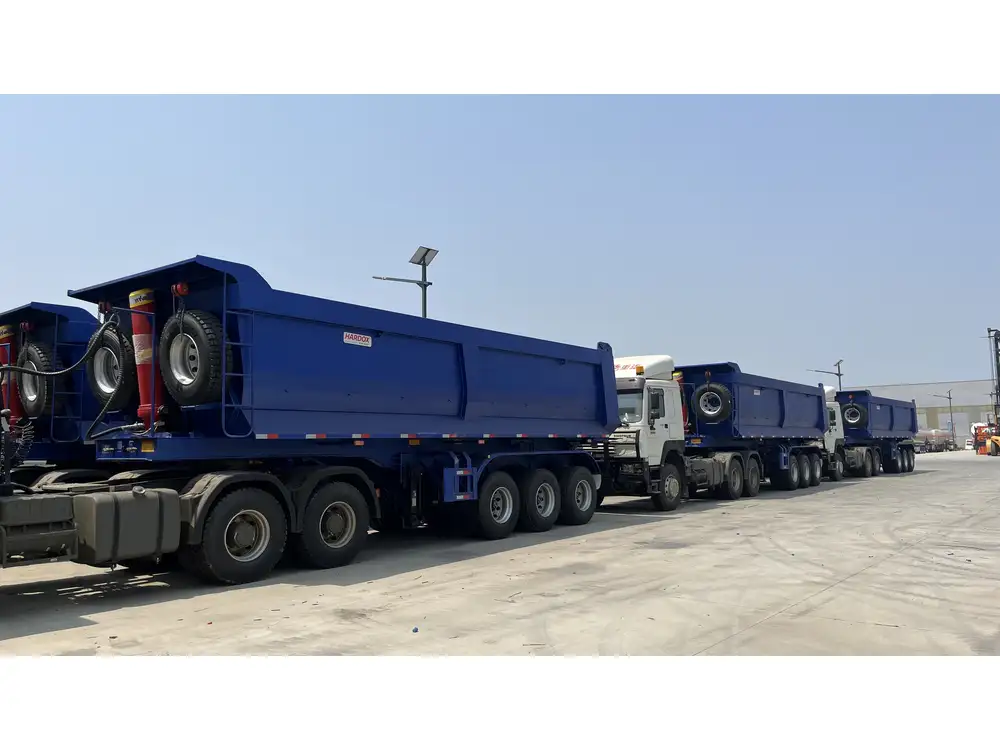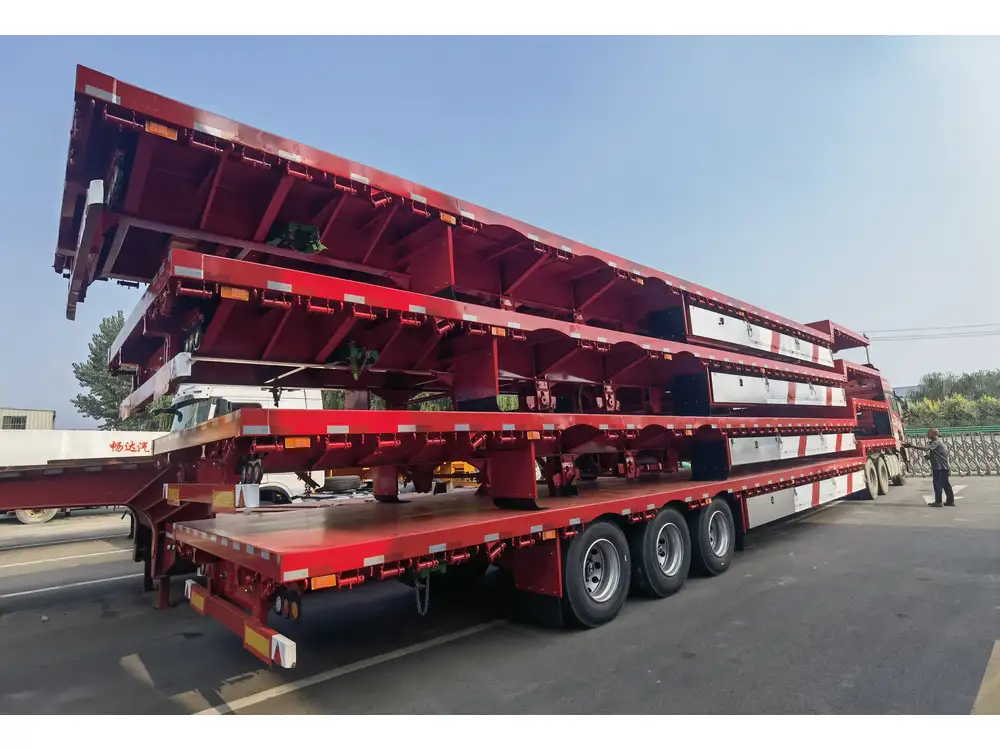Purchasing a flatbed trailer can be a complex task. By navigating through various options, understanding features, and evaluating your specific needs, you can make a well-informed decision. Whether you’re in the logistics business, agriculture, or construction, investing in the right flatbed trailer is paramount for efficiency and productivity. Below, we dissect everything you need to consider.
Understanding Flatbed Trailers
Flatbed trailers, characterized by their level bed platform with no sides or roof, are incredibly versatile. This design facilitates easy loading and unloading of goods using cranes, forklifts, or other heavy equipment. Their applications span across a multitude of industries, from shipping goods to transporting heavy machinery.
Types of Flatbed Trailers
Standard Flatbed Trailers
- Description: These are the most straightforward type, typically 48-53 feet long.
- Best For: General cargo and large shipments.
Drop Deck Trailers
- Description: Featuring a lower deck height, they provide an easier load-in for taller cargo.
- Best For: Transporting taller items that must comply with highway regulations.
Stretch Flatbed Trailers
- Description: These can elongate to transport oversized loads.
- Best For: Very long or heavy loads requiring extra length.
Specialty Flatbed Trailers
- Description: Tailored for specific functions, such as car haulers, equipment haulers, or those with retractable or removable sides.
- Best For: Specific industries or unique cargo types.

Key Features to Consider
| Feature | Importance |
|---|---|
| Material | Steel offers durability; aluminum ensures lightweight and corrosion resistance. |
| Weight Rating | Ensure it meets cargo capacity; check the Gross Vehicle Weight Rating (GVWR). |
| Axles | More axles can increase load capacity and reduce wear. |
| Tires | Quality tires lead to better handling and safety. |
| Braking System | Air brake vs. electric brake systems; consider the safest option for your needs. |
| Tie-Down Points | These should be plentiful and tooled for securement of diverse cargo types. |
Assessing Your Needs
Before diving into various purchasing options, evaluate your business needs:
- Load Capacity: What is the maximum weight you’ll be hauling? This will influence the size and type of trailer.
- Size Requirements: Measure your typical load dimensions. Will standard or custom sizes better suited?
- Regularity of Use: How often will this trailer be used? Frequent use may require more durable options.
- Budget Considerations: Establish a budget that factors in additional costs – maintenance, insurance, and potential accessories.
- Transporting Environment: Will you transport in urban areas with restricted access or on rural backroads? This can shape your choice of trailer features.
Researching Flatbed Trailer Manufacturers
Finding the right manufacturer can significantly affect both the quality of the trailer and your overall purchasing experience. Here are several factors to think about:

Reputation and Experience
- Industry Experience: Look for manufacturers with years of experience. They are generally more reliable.
- Customer Reviews: Research online reviews and testimonials to gauge customer satisfaction.
Product Range
- Diversity of Options: A manufacturer who offers a wide range of trailers can better accommodate specific needs.
- Customization Availability: The ability to custom-tailor a trailer is a significant advantage.
Quality Assurance
- Manufacturing Standards: Ensure they adhere to stringent safety and quality guidelines.
- Warranty and Service: A good warranty indicates the manufacturer’s confidence in their product. Check for service and support availability post-purchase.

Comparing Costs
- Transparent Pricing: Manufacturers should provide clear pricing breakdowns. Compare prices while considering features and quality.
- Total Cost of Ownership: Factor in maintenance, repair, and fuel efficiency when evaluating costs.
The Buying Process
Once you’ve zeroed in on suitable manufacturers, the buying process typically involves several steps:
Step 1: Gather Information and Compare Options
Utilize online resources, trade shows, and industry contacts to gather a comprehensive list of potential trailers. Create a comparison table highlighting key features, prices, and manufacturers. This visual aid can ease decision-making.

Step 2: Visit Dealers and Inspect Trailers
If possible, physically inspect the trailers or visit a dealer’s lot. Look for signs of quality, like weld integrity and the finish of the paint. Engaging directly with dealers allows you to ask questions and potentially negotiate prices.
Inspection Checklist:
| Component | What to Check |
|---|---|
| Frame | Look for cracks or excessive rust. |
| Deck | Ensure it’s level and devoid of weakness. |
| Suspension | Inspect for wear; consider a smoother ride. |
| Electrical Systems | Test lights and wiring for functionality. |
| Tie-Down Systems | Assess strap integrity and system usability. |
Step 3: Review Final Pricing and Negotiate
Once you select a specific trailer, ensure all fees are clearly outlined. Negotiate where possible. Many dealers expect contingency negotiations for bulk purchases or trade-ins.
Step 4: Finalize the Purchase Agreement
Ensure the purchase agreement outlines all aspects of the transaction—payment terms, warranty details, and any included accessories.

Step 5: Transportation and Delivery
Discuss delivery options. Can the manufacturer arrange transportation, or will you pick it up? Check for any applicable shipping fees and ensure they align with industry standards.
Post-Purchase Care and Maintenance
Investing in a flatbed trailer is just the beginning. Proper maintenance maximizes vehicle lifespan and ensures safety.
Regular Maintenance Schedule
| Task | Frequency |
|---|---|
| Inspect tires and wheel bearings | Monthly |
| Check brakes and hydraulics | Bi-Annually |
| Lubricate moving parts | Semi-Annually |
| Clean deck and framework | After every use |

Safety Checks
- Pre-Trip Inspections: Conduct a thorough check of equipment before embarking on long hauls.
- Load Securement Practices: Ensure that loads are properly secured and comply with DOT regulations.
Conclusion
Acquiring a flatbed trailer is not merely a purchase; it’s a strategic investment that can drive efficiency and productivity in your business. By meticulously assessing your needs, researching manufacturers, and adhering to a detailed buying process, you can secure the optimal trailer. The combination of diligent care, thoughtful maintenance, and responsive adjustments to your operations will ensure that your investment continues to yield returns over time.
By following these steps and considerations, you position yourself to make a well-informed acquisition. This will not only enhance your operational capabilities but also streamline your logistical processes, allowing you to meet the diverse demands of your business.



